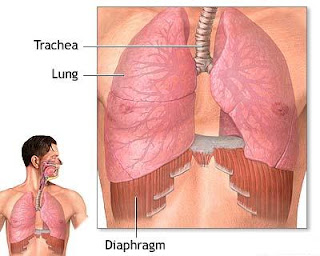The diaphragm is the dominant respiratory muscle for quiet breathing in awake healthy adults, but increased use of chest muscles and increased breathing rate are common results of and may become stresshabitual. Slow diaphragmatic breathing appears to reduce adverse effects of stress and promote parasympathetic cardiovascular dominance. The opposite effects are induced by more rapid breathing using the chest muscles. Before discussing the available data, a brief review of the respiratory process may clarify the nature of these modes of breathing and the methodological issues in their investigation.
Three muscle groups can be used in breathing:
(a) The diaphragm
(b) The muscles of the rib cage
(c) The abdominal muscles
The abdominal muscles are the most powerful and important muscles for forced exhalation, but are normally not used in quiet breathing. Contraction puts inward pressure on the abdominal viscera, which then push the diaphragm up and reduce lung volume. In addition, these muscles may assist expiration by pulling down and deflating the lower rib cage. The important abdominal muscles for respiration are the rectus abdominals, the transverse abdominals, and the external and internal obloquies.
The diaphragm is the most important muscle for inhalation. It is a thin sheet of muscle separating the chest and abdominal cavities. When relaxed the diaphragm forms an open-bottomed cylinder that extends up into the lower part of the rib cage along the sides of the rib cage, and forms a dome on top. Diaphragm contraction shortens the cylindrical portion and pulls the dome down. This movement expands the lungs by pulling them down, which creates a partial vacuum that causes inhalation if the airway is open. When the diaphragm relaxes, the elastic recoil of the lungs pulls it upward, causing exhalation. The downward pressure on the abdominal viscera from contraction of the diaphragm forces the abdominal wall to extend forward and/or the lower rib cage to expand to the sides. The term abdominal breathing derives from this easily observed movement of the abdominal wall, but can also refer to the use of abdominal muscles described below.

I started on COPD Herbal treatment from Ultimate Health Home, the treatment worked incredibly for my lungs condition. I used the herbal treatment for almost 4 months, it reversed my COPD. My severe shortness of breath, dry cough, chest tightness gradually disappeared. Reach Ultimate Health Home via their website www.ultimatelifeclinic.com I can breath much better and It feels comfortable!
ReplyDelete